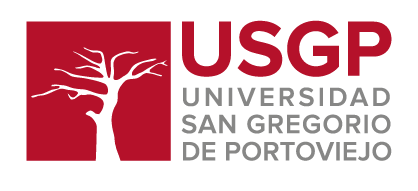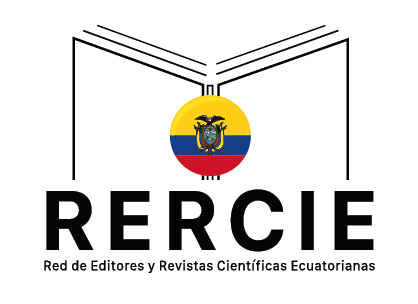Caracterización de terceros molares inferiores incluidos. Portoviejo 2017 -2019
Palabras clave:
Dificultad operatoria, inclusión dentaria, radiografía panorámica, tercer molarResumen
Esta investigación tuvo como objetivo caracterizar los terceros molares inferiores incluidos, de los pacientes atendidos en una consulta privada de la ciudad de Portoviejo en el periodo de 2017 -2019. Se realizó un estudio descriptivo transversal que incluyó las variables: edad, sexo, criterios de referencia para la extracción quirúrgica, clasificación radiográfica de Winter, y de Gregory y Pell; y los criterios modificados de la escala de Parant para medir la dificultad operatoria. El universo fue de 134 pacientes, 62% fueron del sexo femenino, y el 70,2% tenía una edad comprendida entre 20 y 30 años. Se realizó la extracción quirúrgica de 228 molares, la pericoronaritis (41,0%) fue el principal criterio de referencia para la extracción, la radiografía panorámica mostró que la angulación mesioangular (46,15%), y la profundidad de inclusión, posición B (69,35%), fueron las más frecuentes; el 52,2% de las cirugías tuvieron una dificultad operatoria media. La caracterización clínica – radiológica de los terceros molares inferiores incluidos se corresponde con estudios internacionales, aunque se observó que la indicación profiláctica de la extracción quirúrgica en personas menores de 20 años fue baja, lo cual indica la necesidad de un cambio en los criterios sobre las indicaciones y momento de la extracción
Descargas
Referencias
Ali, D. A. (2016). Assessment of oral health attitudes and behavior among students of Kuwait University Health Sciences Center. Journal of International Society of Preventive y Community Dentistry, 6(5), 436. https://doi: 10.4103/2231-0762.192943
Almpani, K. y Kolokitha, O. E. (2015). Role of third molars in orthodontics. World Journal of Clinical Cases: WJCC, 3(2), 132. https://doi: 10.12998/wjcc. v3. i2.132
Al-Zoubi, H., Alharbi, A. A., Ferguson, D. J., y Zafar, M. S. (2017). Frequency of impacted teeth and categorization of impacted canines: A retrospective radiographic study using orthopantomograms. European journal of dentistry, 11(01), 117-121. https://doi: 10.4103/ejd.ejd_308_16
American Association of Oral and Maxillofacial Surgeons. (2016), The Importance of Wisdom Teeth Management. https://link.gale.com/apps/doc/A456792543/GPS?u=sangregorio_ecysid=GPSyxid=430a3ca0
Bali, A., Bali, D., Sharma, A., y Verma, G. (2013). Is Pederson index a true predictive difficulty index for impacted mandibular third molar surgery? A meta-analysis. Journal of maxillofacial and oral surgery, 12(3), 359-364. https://doi: 10.1007/s126630120435x
Braimah, R. O., Ndukwe, K. C., Owotade, F. J. y Aregbesola, S. B. (2016). Oral health related quality of life (OHRQoL) following third molar surgery in Sub-Saharan Africans: an observational study. The Pan African Medical Journal, 25.
Camargo, I. B., Sobrinho, J. B., de Souza Andrade, E. S. y Van Sickels, J. E. (2016). Correlational study of impacted and non-functional lower third molar position with occurrence of pathologies. Progress in orthodontics, 17(1), 26. https://doi: 10.1186/s4051001601398
Carter, K. y Worthington, S. (2016). Predictors of third molar impaction: a systematic review and meta-analysis. Journal of dental research, 95(3), 267-276. https://doi: 10.1177/0022034515615857
Cheng, H. C., Peng, B. Y., Hsieh, H. Y., & Tam, K. W. (2018). Impact of third molars on mandibular relapse in post-orthodontic patients: A meta-analysis. Journal of dental sciences, 13(1), 1-7. https://doi: 10.1016/j.jds.2017.10.005
de Carvalho, R. W. F. y do Egito Vasconcelos, B. C. (2014). Is overweight a risk factor for adverse events during removal of impacted lower third molars? The Scientific World Journal, 2014. https://doi: 10.1155/2014/589856
Díaz Pérez CA, Martínez Rodríguez M, Simóns Preval SJ, Legrá Silot DB, Blanco Caballero MV, Yebil Odilio D. (2008). Extracción de terceros molares inferiores retenidos en adolescentes. Rev Inf Cient, 58(2). http://www.revinfcientifica.sld.cu/index.php/ric/article/view/1345
El-Anwar, M. W., Amer, H. S., y Ahmed, A. F. (2016). Relation of Lower Last Molar Teeth with Mandibular Fractures. Journal of Craniofacial Surgery, 27(7), e713-e716.
Genest-Beucher, S., Graillon, N., Bruneau, S., Benzaquen, M., & Guyot, L. (2018). Does mandibular third molar have an impact on dental mandibular anterior crowding? A literature review. Journal of stomatology, oral and maxillofacial surgery, 119(3), 204-207. https://doi: 10.1016/j.jormas.2018.03.005
Hamasha, A. A. H., Alshehri, A., Alshubaiki, A., Alssafi, F., Alamam, H., y Alshunaiber, R. (2018). Gender-specific oral health beliefs and behaviors among adult patients attending King Abdulaziz Medical City in Riyadh. The Saudi dental journal, 30(3), 226-231.
Jakovljevic, A., Andric, M., Knezevic, A., Milicic, B., Beljic-Ivanovic, K., Perunovic, N. y Milasin, J. (2016). Herpesviral-bacterial co-infection in mandibular third molar pericoronitis. Clinical oral investigation, 21 (5), 1639-1646. https://doi: 10.1007/s00784-016-1955-4
Kaczor-Urbanowicz, K., Zadurska, M., y Czochrowska, E. (2016). Impacted Teeth: An Interdisciplinary Perspective. Advances in clinical and experimental medicine: official organ Wroclaw Medical University, 25(3), 575-585. https://doi:10.17219/acem/37451
Kharma, M. Y., Sakka, S., Aws, G., Tarakji, B., y Nassani, M. Z. (2014). Reliability of Pederson Scale in Surgical Extraction of Impacted Lower Third Molars: Proposal of New Scale. Journal of Oral Diseases. https://www.hindawi.com/journals/jod/2014/157523/
Katsarou, T., Kapsalas, A., Souliou, C., Stefaniotis, T. y Kalyvas, D. (2019). Pericoronitis: a clinical and epidemiological study in greek military recruits. Journal of clinical and experimental dentistry, 11(2), e133. https://doi: 10.4317/jced.55383
Kumar, S. R., Sinha, R., Uppada, U. K., Reddy, B. R. y Paul, D. (2015). Mandibular third molar position influencing the condylar and angular fracture patterns. Journal of maxillofacial and oral surgery, 14(4), 956-961. https://doi: 10.1007 / s12663-015-0777-2
Magraw, C. B., Golden, B., Phillips, C., Tang, D. T., Munson, J., Nelson, B. P. y White, R. P. (2015). Pain with pericoronitis affects quality of life. Journal of Oral and Maxillofacial Surgery, 73(1), 7-12. https://doi: 10.1016/j.joms.2014.06.458
Mamai-Homata, E., Koletsi-Kounari, H., y Margaritis, V. (2016). Gender differences in oral health status and behavior of Greek dental students: A meta-analysis of 1981, 2000, and 2010 data. Journal of International Society of Preventive y Community Dentistry, 6(1), 60. https://doi: 10.4103/2231-0762.175411
Manuel, S., Kumar, L. S., y Varghese, M. P. (2014). A comprehensive proforma for evaluation of mandibular third molar impactions. Journal of maxillofacial and oral surgery, 13(4), 378-385. https://doi: 10.1007/s1266301305432
McArdle, L. W., Jones, J., y McDonald, F. (2019). Characteristics of disease related to mesio-angular mandibular third molar teeth. British Journal of Oral and Maxillofacial Surgery, 57(4), 306-311. https://doi: 10.1038/s41415-019-0199-5
Normando, D. (2015). Third molars: To extract or not to extract? Dental press journal of orthodontics, 20(4), 17-18. https://doi: 10.1590/21769451.20.4.017018.edt.
Nunn, M. E., Fish, M. D., Garcia, R. I., Kaye, E. K., Figueroa, R., Gohel, A., y Miyamoto, T. (2013). Retained asymptomatic third molars and risk for second molar pathology. Journal of dental research, 92(12), 1095-1099. https://doi: 10.1177/0022034513509281
Park, K. L. (2016). Which factors are associated with difficult surgical extraction of impacted lower third molars? Journal of the Korean Association of Oral and Maxillofacial Surgeons, 42(5), 251-258. https://doi: 10.5125/jkaoms.2016.42.5.251
Patel, S., Mansuri, S., Shaikh, F. y Shah, T. (2017). Impacted mandibular third molars: a retrospective study of 1198 cases to assess indications for surgical removal, and correlation with age, sex and type of impaction—a single institutional experience. Journal of maxillofacial and oral surgery, 16(1), 79-84. https:// doi: 10.1007 / s12663-016-0929-z
Sánchez-Torres, A., Soler-Capdevila, J., Ustrell-Barral, M., y Gay-Escoda, C. (2019). Patient, radiological, and operative factors associated with surgical difficulty in the extraction of third molars: a systematic review. International journal of oral and maxillofacial surgery. https:// doi: 10.1016 / j.ijom.2019.10.009
Santosh, P. (2015). Impacted mandibular third molars: Review of literature and a proposal of a combined clinical and radiological classification. Annals of medical and health sciences research, 5(4), 229-234. https://doi: 10.4103/2141-9248.160177
Shin, S. M., Choi, E. J. y Moon, S. Y. (2016). Prevalence of pathologies related to impacted mandibular third molars. Springerplus, 5(1), 915. https://doi: 10.1186/s4006401626404
Silva, L.F., Thomaz E.B., Freitas, H.V., Ribeiro, C.C., Pereira, A.L. y Alves, C.M. (2016). Self-perceived need for dental treatment and related factors. A cross-sectional population-based study. Brazilian Oral Research, 30(1), e55. Epub May 31, 2016. https://dx.doi.org/10.1590/1807-3107BOR-2016.vol30.0055
Srivastava, N., Shetty, A., Goswami, R. D., Apparaju, V., Bagga, V. y Kale, S. (2017). Incidence of distal caries in mandibular second molars due to impacted third molars: Nonintervention strategy of asymptomatic third molars causes harm? A retrospective study. International Journal of Applied and Basic Medical Research, 7(1), 15. https://doi: 10.4103/2229516X.198505
Toedtling, V. y Yates, J. M. (2015). Revolution vs status quo? Non-intervention strategy of asymptomatic third molars causes harm. British dental journal, 219(1), 11. https://doi: 10.1038/sj.bdj.2015.525
Descargas
Archivos adicionales
Publicado
Número
Sección
Licencia
Derechos de autor 2020 Revista San Gregorio

Esta obra está bajo una licencia internacional Creative Commons Atribución-NoComercial-SinDerivadas 4.0.



















